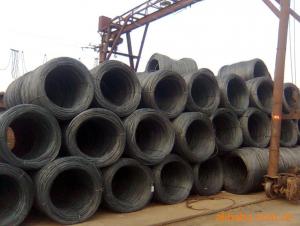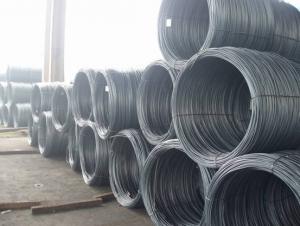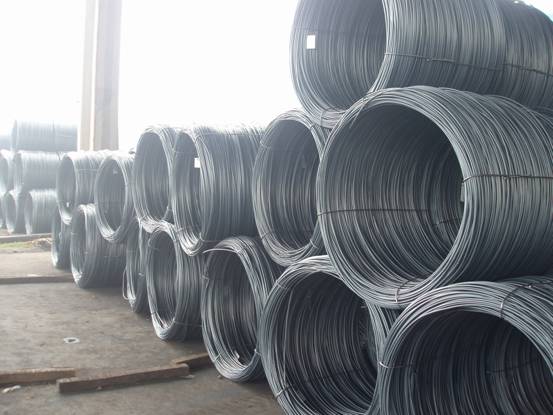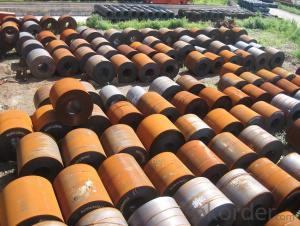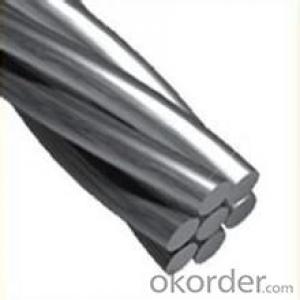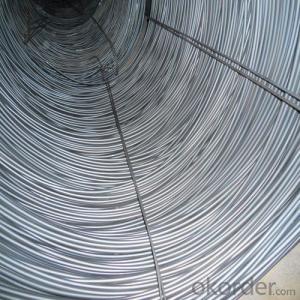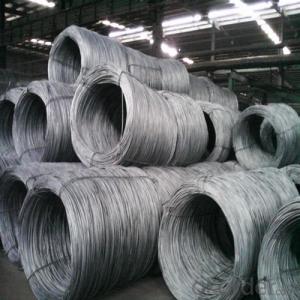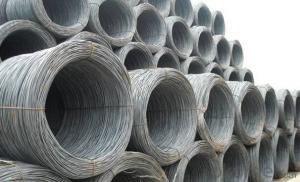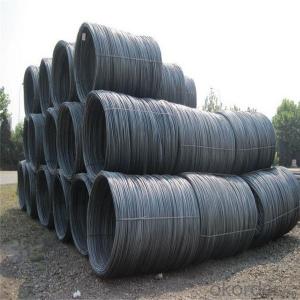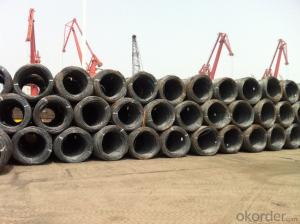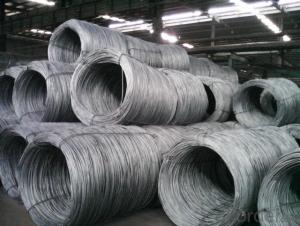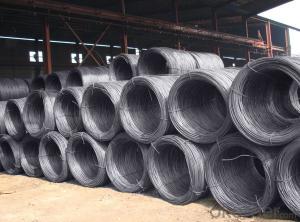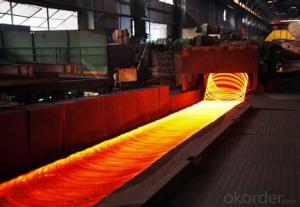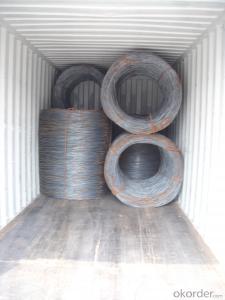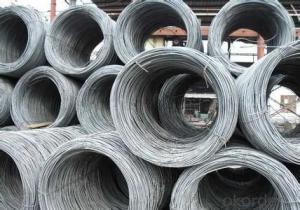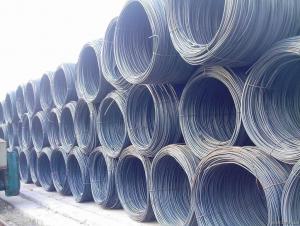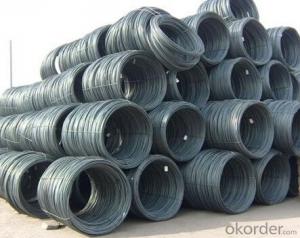Wire Rod SAE1008
- Loading Port:
- China Main Port
- Payment Terms:
- TT OR LC
- Min Order Qty:
- -
- Supply Capability:
- -
OKorder Service Pledge
OKorder Financial Service
You Might Also Like
Product Description:
Specifications of Hot Rolled Wire Rod:
Steel Grade: Q195/235, SAE1006-1018B Standard: ASTM, GB
Diameter: 5.5mm, 6.5mm, 7mm,8mm,9mm,10mm,12mm,14mm
Type: in coil, coil weight around 2MT Alloy or Not: Alloy
Technique: Hot Rolled Place of Origin: China Mainland
Surface: round, no twisted, light and smooth Brand Name: HSKY
Chemical Composition: (Please kindly find our chemistry of our material based on Q195、Q235A and Q235B as below for your information)
| Trademark | Rank | Chemical composition (quality score) % | ||||
| C | Si | Mn | S | P | ||
| ≤ | ≤ | ≤ | ||||
| Q195 | 0.06-0.12 | 0.30 | 0.25 | 0.050 | 0.045 | |
| Q235 | A | 0.14-0.22 | 0.30 | 0.30-0.65 | 0.050 | 0.045 |
| Q235 | B | 0.12-0.20 | 0.30 | 0.30-0.70 | 0.045 | 0.045 |
Usage and Applications of Hot Rolled Wire Rod:
After hot-rolled the products shaped into coil and delivery as finished product, including round, square, rectangular, hexagonal and so on. Since most of the products are round, it is generally called wire rod. Carbon steel wire rod is widely used in construction and manufacturing. Carbon steel wire rod is mainly used for reinforcement of reinforced concrete and welded structure or reprocessed (roberts , nail, etc.) materials, especially used to produce wire drawing, welding electrode, nails, spring, electronic, precise machinery parts and so on.
Packaging & Delivery of Hot Rolled Wire Rod:
Packaging Detail: products are packed in coil, each coil weight around 2 MT, and then shipped by container or bulk vessel
Delivery Detail: within 45 days after received deposit or LC.
Label: to be specified by customer, generally, each bundle has 1-2 labels
Trade terms: FOB, CFR, CIF
- Q: How is the decarburization of steel wire rod evaluated?
- Various methods and techniques are employed to evaluate the decarburization of steel wire rod, ensuring the final product's quality and properties. Visual inspection is a common evaluation method, whereby the wire rod's surface is carefully examined for signs of decarburization, such as discoloration or scaling. This preliminary assessment offers insights into the level of decarburization. Chemical analysis is also conducted to determine the carbon content at different depths of the wire rod. Samples are taken from various sections of the wire rod and subjected to carbon analysis tests. The results of this analysis reveal the extent of decarburization and aid in assessing its impact on the steel wire rod's mechanical properties. Microscopic examination is a crucial evaluation technique. Metallographic analysis involves preparing thin sections of the wire rod and observing them under a microscope. This allows for a detailed examination of the microstructure, facilitating the identification of any areas affected by decarburization. Specialized equipment, such as image analysis software, can be used to measure the depth and severity of decarburization. Moreover, mechanical testing is performed to evaluate the impact of decarburization on the wire rod's mechanical properties. Tensile strength, hardness, and ductility tests are commonly conducted to assess the wire rod's overall strength and behavior under different conditions. Any significant deviation from the desired mechanical properties may indicate a higher level of decarburization. In conclusion, the evaluation of decarburization in steel wire rod involves a combination of visual inspection, chemical analysis, microscopic examination, and mechanical testing. These techniques provide a comprehensive understanding of the extent and impact of decarburization, ensuring that the wire rod meets the required quality standards and specifications.
- Q: How does the fatigue strength of steel wire rod vary with different heat treatment processes?
- The fatigue strength of steel wire rod can vary significantly depending on the methods of heat treatment employed. Heat treatment involves subjecting the steel wire rod to specific heating and cooling processes in order to change its microstructure and mechanical properties. One commonly used heat treatment process to improve the fatigue strength of steel wire rod is quenching and tempering. This process includes heating the wire rod to a high temperature and then rapidly cooling it (quenching) to achieve a hardened microstructure. This leads to an increase in the fatigue strength of the wire rod because the hardened structure provides better resistance against fatigue failure. The subsequent tempering process involves reheating the wire rod to a lower temperature and slowly cooling it, which helps to relieve internal stresses and improve the toughness of the wire rod while maintaining an optimum balance of strength and ductility. On the other hand, if the steel wire rod undergoes a heat treatment process at a lower temperature, such as annealing, the fatigue strength may be reduced. Annealing involves heating the wire rod to a specific temperature and allowing it to cool slowly, often in a controlled atmosphere. This process is used to soften the wire rod, relieve internal stresses, and improve its machinability and formability. However, the resulting softer microstructure may cause a decrease in fatigue strength compared to quenched and tempered wire rod. In conclusion, the fatigue strength of steel wire rod can be improved through heat treatment processes like quenching and tempering, which lead to a hardened microstructure. Conversely, heat treatment processes like annealing can decrease the fatigue strength by producing a softer microstructure. Therefore, the selection of heat treatment processes is crucial in determining the fatigue strength of steel wire rod.
- Q: What are the different types of steel wire rod coatings?
- There are several types of coatings that can be applied to steel wire rods, including zinc, copper, chrome, and epoxy coatings. These coatings help enhance the wire rod's durability, corrosion resistance, and overall performance in various applications.
- Q: How is steel wire rod used in the manufacturing of wire forms for fishing nets?
- Steel wire rod is a crucial component in the manufacturing of wire forms for fishing nets. The wire rod serves as the raw material from which the wire forms are created. Firstly, the steel wire rod is processed through a series of steps to transform it into a usable wire form. This includes cleaning, annealing, and drawing the wire rod to achieve the desired diameter and tensile strength. These processes ensure that the wire is strong and flexible enough to withstand the tension and stress it will experience when used in fishing nets. Once the wire rod is transformed into wire, it is then used to create the various wire forms required for fishing nets. These wire forms include various components such as hoops, rings, loops, and connectors that are essential for constructing a functional fishing net. The wire forms are created using specialized machinery and techniques, including bending, cutting, and welding the wire according to the specific design requirements. These wire forms are then assembled together to form the net structure. The use of steel wire rod in the manufacturing of wire forms for fishing nets provides numerous advantages. Steel is known for its high strength and durability, making it ideal for withstanding the harsh conditions and constant tension that fishing nets are subjected to. Additionally, steel wire rod is resistant to corrosion, ensuring that the wire forms will have a long lifespan even when exposed to water and other environmental factors. In conclusion, steel wire rod is a vital component in the manufacturing of wire forms for fishing nets. It serves as the raw material from which the wire forms are created, providing the necessary strength, flexibility, and durability required for a functional fishing net.
- Q: How is steel wire rod used in the production of springs?
- Steel wire rod is used in the production of springs as it serves as the raw material for manufacturing spring wires. The wire rod undergoes a series of processes such as drawing, annealing, and tempering to transform it into high-quality spring wires with specific characteristics. These spring wires are then utilized in various applications, including automotive, aerospace, and industrial sectors, where they provide resilience and elasticity to the springs, allowing them to absorb and release energy efficiently.
- Q: How is the ductility of steel wire rod measured?
- The ductility of steel wire rod is typically measured using a test called the tensile test, also known as the tension test. In this test, a sample of the steel wire rod is subjected to gradually increasing tensile forces until it fractures. Throughout the test, the elongation or deformation of the sample is measured, which provides an indication of its ductility. During the tensile test, the steel wire rod sample is clamped at both ends and a gradually increasing force is applied to one end. As the force is applied, the sample begins to elongate, and the amount of elongation is recorded. This elongation is usually measured as a percentage of the original length of the sample and is called the percentage elongation. In addition to measuring the elongation, the tensile test also measures the ultimate tensile strength of the steel wire rod. This is the maximum stress that the sample can withstand before it fractures. The ultimate tensile strength is an important parameter in assessing the overall mechanical properties of the steel wire rod. By conducting tensile tests on multiple samples of the steel wire rod, the average ductility of the material can be determined. This information is crucial in various industries that utilize steel wire rod, such as construction, automotive, and manufacturing, as it helps engineers and designers understand how the material will behave under different loads and conditions.
- Q: How is steel wire rod used in the manufacturing of wire for water filtration systems?
- Steel wire rod is an essential element in the production of wire used in water filtration systems. It serves as the initial material that undergoes various processes to create the wire for these systems. To begin, high-quality carbon or alloy steel is typically used to make the steel wire rod, ensuring that the final product is durable and strong. The rod then goes through a series of manufacturing steps, including hot rolling, cold drawing, and annealing. During the hot rolling process, the steel wire rod is heated and passed through rollers to decrease its diameter and increase its length. This step helps refine the internal structure of the steel and enhance its mechanical properties. Following this, the cold drawing process further reduces the diameter of the wire rod and improves its surface finish. This involves pulling the rod through dies, gradually reducing its size while enhancing its dimensional accuracy and surface quality. After the cold drawing process, the wire rod is typically annealed to relieve internal stresses and increase its ductility. Annealing entails heating the wire to a specific temperature and slowly cooling it down. This process enhances the wire's flexibility and makes it easier to work with during subsequent manufacturing stages. Once the steel wire rod has undergone hot rolling, cold drawing, and annealing, it is ready for the final steps in wire production. These involve shaping and coating the wire based on the specific requirements of the water filtration system. Depending on the design of the filtration system, the wire may be shaped into various forms like mesh, woven wire cloth, or spiral wound wire. It may also undergo a coating process, where materials such as PVC or polyethylene are applied to enhance corrosion resistance and prolong its lifespan. In summary, steel wire rod is a critical component in the production of wire for water filtration systems. Through a series of manufacturing processes, the rod is transformed into a highly functional wire that possesses the necessary strength, durability, and filtration capabilities required for efficient water purification.
- Q: Round in high wire and ordinary line what is the difference?
- P line: refers to the use of "ordinary mill (usually open-train double wire rod rolling mill)". The rolling speed of 20-60 meters per second, per root weight (disc) in 0.4-0.6 tons (market show is generally three root six head is a market), in the rolling process can only be cooled by air cooling or air cooling line to ensure product performance.Round bar is divided into three parts: hot rolling, forging and cold drawing. Standard Specification for hot rolled round steel is 5.5-250 mm. Of which: 5.5-25 mm small round bars are mostly supplied by straight strips. They are used as reinforcing bars, bolts and various mechanical parts. Round bars larger than 25 millimeters are used mainly for making mechanical parts or for seamless steel tubes.
- Q: How is steel wire rod tested for dimensional accuracy?
- Steel wire rod is tested for dimensional accuracy through a process called diameter measurement. This involves using calibrated measuring instruments, such as micrometers or laser sensors, to precisely measure the diameter of the wire rod at different points along its length. These measurements are then compared to the specified tolerances and standards to ensure that the wire rod meets the required dimensional accuracy.
- Q: What are the different types of corrosion resistance tests conducted on steel wire rod?
- Steel wire rods commonly undergo several corrosion resistance tests to determine their ability to withstand corrosion in different environments. These tests include: 1. Salt Spray Test: In this test, the wire rod is exposed to a continuous salt spray environment. It is placed in a chamber where it undergoes misting with a saline solution. The test measures the time it takes for the wire rod to exhibit signs of corrosion, such as the formation of rust. 2. Humidity Test: This test exposes the wire rod to a high humidity environment for a specific duration. The humidity level is controlled, and the wire rod is examined for any indications of corrosion, such as surface discoloration or oxidation. 3. Cyclic Corrosion Test: This test subjects the wire rod to repeated cycles of various corrosive conditions, including salt spray, humidity, and dry heat. The rod is exposed to these conditions in a controlled manner, and its resistance to corrosion is evaluated based on the appearance and extent of corrosion after each cycle. 4. Electrochemical Corrosion Test: This test utilizes electrochemical techniques to measure the corrosion potential and corrosion current of the wire rod. The rod is immersed in a corrosive solution, and its response to an applied electrical potential is assessed. This test provides valuable insights into the corrosion behavior and performance of the wire rod. 5. Acid Resistance Test: The acid resistance test assesses the wire rod's ability to resist corrosion caused by acids. The rod is immersed in an acidic solution for a specified period, and the extent of corrosion is determined by measuring weight loss or examining surface appearance. 6. Pitting Corrosion Test: Pitting corrosion is a localized and harmful form of corrosion. This test exposes the wire rod to a corrosive environment that promotes pitting corrosion. After exposure, the rod is inspected visually or under a microscope to identify the presence and extent of pits. These examples illustrate the different corrosion resistance tests conducted on steel wire rods. Each test provides valuable information about the rod's ability to withstand corrosion in specific conditions, ensuring its suitability for various applications.
Send your message to us
Wire Rod SAE1008
- Loading Port:
- China Main Port
- Payment Terms:
- TT OR LC
- Min Order Qty:
- -
- Supply Capability:
- -
OKorder Service Pledge
OKorder Financial Service
Similar products
Hot products
Hot Searches
Related keywords

